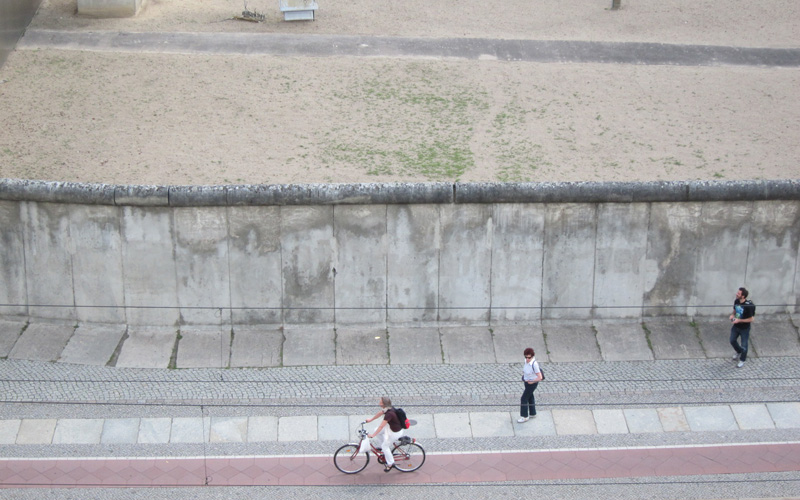
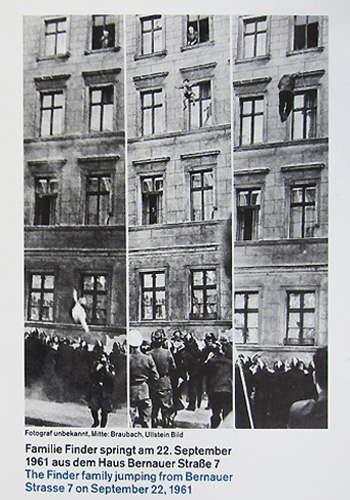 Before last summer we had visited East and West Berlin in 1985 and looked forward to seeing the changes that occurred in the 23 years since the Fall of the Wall on November 9, 1989. Our cultural subconscious held a cache of images of horrid truths and heartless propaganda: juddering film clips of goose-stepping Nazis and skeletal prisoners, Walter Cronkite’s TV voice over of the Wall’s construction, and AP photos of East Berlin escapees in mid-air jumping to freedom or death from walls and walled buildings. The images form a deep, muddy cold-war pool from which the vitality of modern Berlin emerges, staggering out of the emotional depth and intellectual complexity.
Before last summer we had visited East and West Berlin in 1985 and looked forward to seeing the changes that occurred in the 23 years since the Fall of the Wall on November 9, 1989. Our cultural subconscious held a cache of images of horrid truths and heartless propaganda: juddering film clips of goose-stepping Nazis and skeletal prisoners, Walter Cronkite’s TV voice over of the Wall’s construction, and AP photos of East Berlin escapees in mid-air jumping to freedom or death from walls and walled buildings. The images form a deep, muddy cold-war pool from which the vitality of modern Berlin emerges, staggering out of the emotional depth and intellectual complexity.
The marks of last centuries’ history, written with bullets, bombs and barbed wire, still remain visible in places but disappear quickly with the massive new architectural construction of the last two decades. This March protests arose over the demolishing of a long and fantastically graffitied vestige of the Berlin Wall, called the East Side Gallery (listed below), to make way for luxury condos–this in a city only 3/4 occupied. Formerly a symbol of oppression, the Wall has been claimed as a battle trophy by artists and activists who have repossessed the emotional weight of the Wall’s history as a symbol of self expression and threatened freedom. Among the works at the East Side Gallery Dmitri Vrubel’s street art perversely commemorates Erich Honecker and Leonid Brezhnev’s historic kiss, passionately celebrating the 30th anniversary of Soviet control of East Germany, “My God. Help Me Survive This Deadly Love”.

Because its history is so dark, modern Berlin has uniquely embraced it and memorialized it, largely without the masks and costumes of bombast and glory typically associated with memorials, of which those of the historic Prussia and Soviet Berlin are extreme. The Doonesbury-like statuary at Friedrich the Greats Neues Palais at Sanssouci (at left), not unlike the Third Reich itself, pushed Deutschland’s tragic romance with glory and death to a chaotic absurdity, exhausting loss’s decorative potential.


Post Cold War Berlin has another idea. In a positive way Berlin’s “Gedenkstætte”–places of recollection– form a popular tourist industry. They combine historical information with an architectural focus for reflection upon the cities own horrific losses and the consequences of confusing loss and glory. The effect is emotional powerful, disturbing and entertaining.
Among the places of recollection
- the Holocaust Memorial: a super-scale field of concrete blocks envisioning a Jewish Cemetery next to the Brandenburg Gate suitable for grieving or sunbathing. Architect: Peter Eisenman.
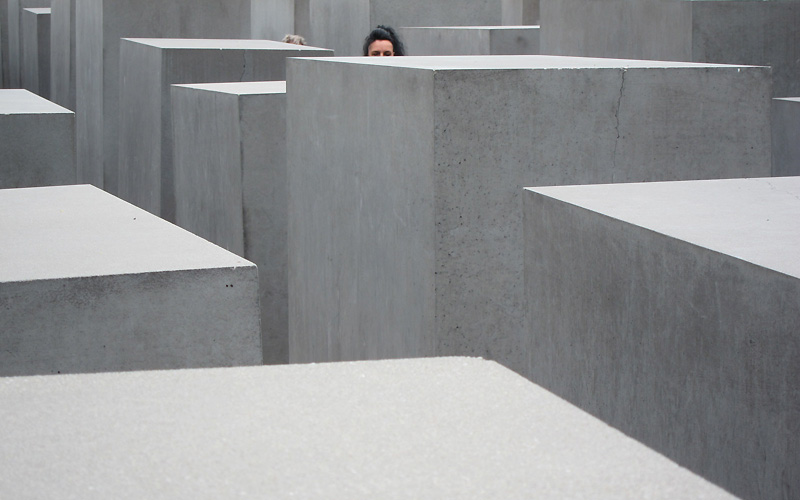
- the Topography of Terrors: Nazi Forced Labor Documentation Center naming names and historically detailing in exhaustive photos and text the Nazi reign of terror including relocations, forced labor, social manipulation, public complicity, defeat, accusals, trials and on-going convictions. Architect: Ursula Wilms.

- Mauerpark and the Berlin Wall Memorial: A personal favorite, both a very serious memorial and a park for music, play, market, etc., including a preserved Berlin Wall segment and Death Strip, a viewing tower chronicling the history of the partitioning of Berlin, and the serene rammed earth Chapel of Reconciliation remembering a demolished east/west church divided by the wall. The variety of physical representations of the Wall and the Iron Curtain’s damaging history is incredible, and the number if not the scale rivals the Theme park approach of the Capitol Mall but with less cherry blossom draped reflecting pools and more photographic evidence, text and mangled concrete–architecturally, artistically, photographically, educationally and emotionally stunning while still appropriate for picnicking and tanning. Architects of the Chapel: Rudolf Reitermann and Peter Sassenroth.

- the Eastside Gallery: a threatened Berlin Wall Segment and Street Art gallery.
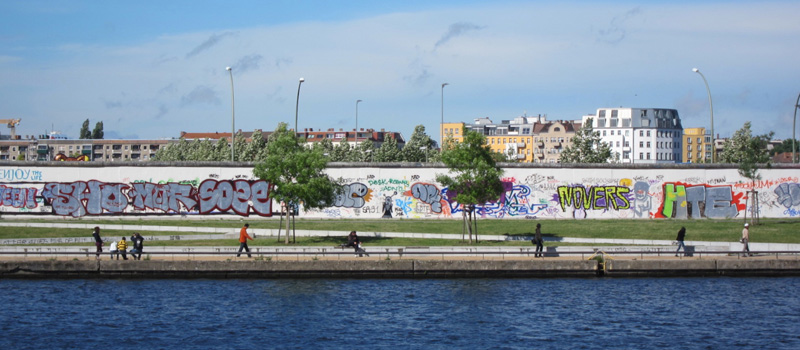
- the Jewish Museum: dizzying architectural moments mismatched with wordy educational exhibits on the history of the Jewish people. Architect: Daniel Liebeskind.
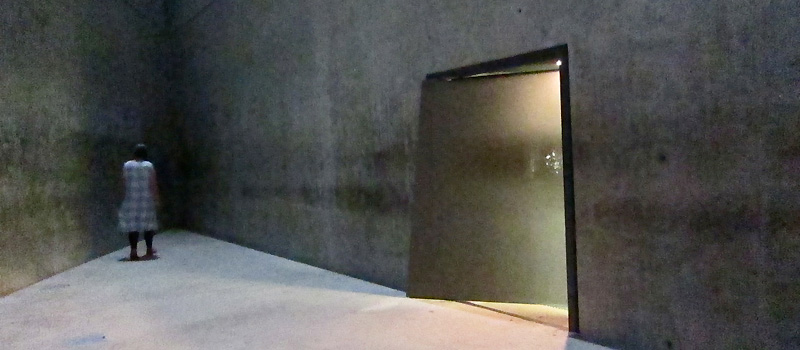
- the Memorial to the Book Burning: a sidewalk window into an empty subterranean library, at left below. Artist: Micha Ullman.)
- the Soviet War Memorial to the Red Army Dead and Stalinist hit piece. See our previous post. Architect: Yakov Belopolsky.
- the Karl-Marx-Allee Sibylle Cafe and Exhibition chronicling the Soviet forced re-building of Berlin as a stylish socialist utopia, at right below, the boulevard formerly known by the Cold War name the Stalinallee. Architects: Hartmann, Henselmann, Hopp, Leucht, Paulick and Souradny.
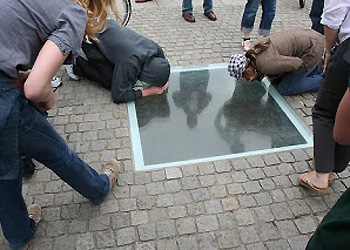

With the Soviet War exception, these monuments aren’t celebrations of valor but serious meditations on loss of lives and spirit under two regimes. That the history is recent and disturbing, makes its memory that much more palpable, dimensional and personal. The visitor owns the history through horror’s catharsis and awakens to find themselves suddenly present at history’s fulcrum.
Thanks to Diane Watson for her fantastic image of the Book Burning Memorial and Gary Trudeau for Doonesbury’s “W”. We also recommend Isabella Oppen‘s study of Berlin’s Book Burning Memorial:”Sculpting Memory” reflecting upon the construction of a collective memory through the “memory work” performed by the state–both East and Unified Berlin, by the historian, by the artist, by the citizen and by the tourist. Thanks also to Lou Reed in Berlin.
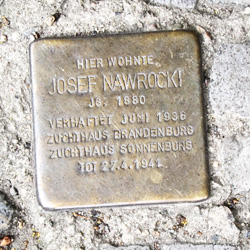

Excellent post. As you may remember I was continually, deeply moved by all the memorials in Berlin, which I felt, for the most part, were done with intelligence and care.
This post is dedicated to Stuart who inspired our voyage with his enthusiastic reports of a city emerging from ruins into the modern world, raising history without rebuilding a fantasy and without confusing preservation with stasis.